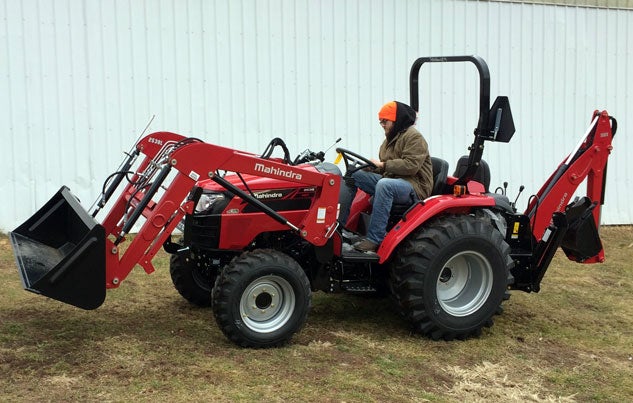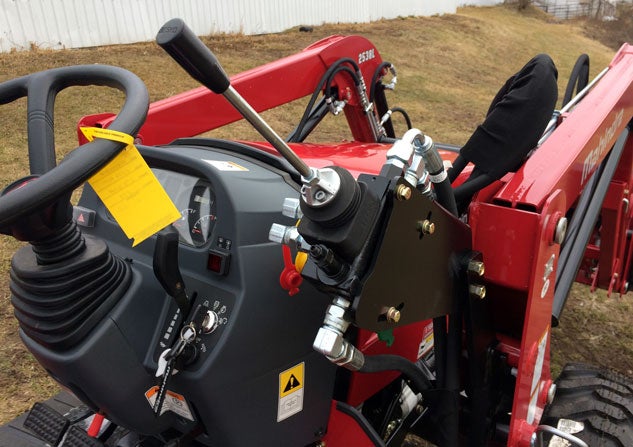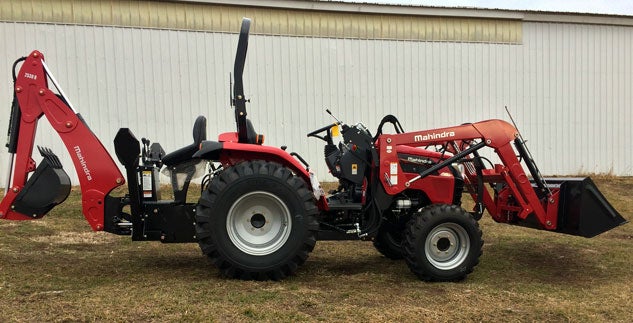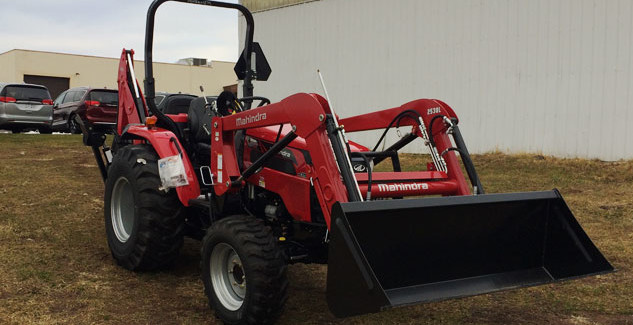2017 Mahindra 2538 TLB
Last year, in a three-part series, Tractor.com brought our readers an inside look at how Mahindra’s deluxe 1538 in tractor-loader-backhoe (TLB) dress performed in a long-term get-it-dirty real world test. Our takeaway from those months of use was that the 1538 performed well under every circumstance we encountered and that anyone in the market for a 38hp TLB setup would do well to consider the Mahindra offering.

We did wonder, however, how the Mahindra 2538 TLB might compare. Thanks goes to the good folks at Ellington Agway Power Equipment in Ellington, Conn. who made a 2538 TLB available for us to make that comparison.
Powering the 2538 is the same Mahindra four-cylinder 167-cubic-inch engine as used on the 1538. Rated output for the 2538 is slightly different: 37.4 gross horsepower vs. 38.7 on the 1538. Power take-off (PTO) horsepower (at 2400 rpm) is also rated differently, with the 2538 having 31 and the 1538 having 27.7 (HST). While we’re not sure why the power ratings differ, the engines are EPA Final Tier 4 (FT4) compliant using Mahindra’s mCRD technology that doesn’t require a diesel particulate filter (DPF) or additions of a second urea-based fluid (DEF). The benefits, of course, are cost – a DPF filter is not inexpensive and DEF needs to be purchased and stored – but those benefits also carry over to the operation and use, where no heat inducing regenerative cycling is needed. We measured acceptable 84/93 dBA readings from the operator seat.

For the 2538, only one transmission choice is available, a three-range hydrostatic unit (HST) controlled by a side-by-side pedal arrangement. As with the 1538, high is strictly transport and runs out of oomph on any kind of slope, medium is a real working range, and low is a bulldozer. The side-by-side pedal arrangement gets high marks and offers well-modulated control over the entire forward/reverse speed range.
Hydraulics also differ from the 1538, which has an open center system flowing 11.1 gpm (3.4 power steering/7.7 implement). For the 2538, the system is a dual gear pump flowing 12.7 gpm (4.5 power steering/8.2 implement). Three-point hitch (3PH) lift capacity is the same: 2646 lbs. Position control on the 1538 and 2538 is standard, so an implement can consistently be returned to a preset point.

The 2538 gets a slightly different loader than the 1538. The 2538L can lift 1634 lbs to a max lift height of 101.4”, has a dump clearance of 79.3”, 4.5” dig depth, and sports a 66” bucket as standard equipment. Compare that to the 1538L, which can lift 1650 lbs to a max height of 99”, has a dump clearance of 79.8”, 6” dig depth, and comes with a 60” bucket. Loader cycle times are nearly identical. Control over the loader, though, is quite different. Whereas the joystick on the 1538 is nicely incorporated into the right fender cowl, the 2538 has the joystick mounted on top of the loader stanchion. The 2538L also comes with two stands vs. the single stand on the 1538L.
The backhoe used on the 2538 (2538B) has the same specs as the 1538B, with the exception of dig force ratings at the bucket and dipper stick. Max dig depth is 94” with a 127” reach, 180-degree swing arc, and 2050 psi system relief valve setting. While the 1538B has a bucket dig force rating of 2900 lbs, the 2538B is rated at 3190 lbs. And while the 1538B has a dipper stick dig force rating of 1800 lbs, the 2538B is rated at 1980 lbs. The 2538B also has a separate stationary seat vs. the swivel seat on the 1538B. It’s a tradeoff getting off the seat and swiveling to change use vs. getting off and up onto the second seat, but it also places the backhoe controls out of reach while sitting in the operator seat.
Walking around the 2538 and comparing it to a nearby 1538, we noticed a number of differences. Up front, the steering rod is in front of the axle. While we wouldn’t call it unprotected, the 2538 definitely has a less protected steering rod placement than on the 1538. The fuel tank on the 2538 is located behind the operator’s seat, which is a little easier to get at location than the 1538, where the tank is accessed on the hood. There also is a nine-gallon capacity on the 2538 vs. 7.7 gallons on the 1538. Comparing seats, the 1538 seat is a little nicer, though the 2538 seat we’d call industry comparable. The big difference is the location, where the 2538 is positioned lower. While this may give an operator a little more stable feeling, it also reduces their visibility outward and around the tractor.
Another difference we noticed was at the exhaust routing. The 1538 is routed out front while the 2538 dumps the exhaust to the port side (left). We did like the left side position of the split brakes on the 2538 vs. the brake pedal above the treadle pedal on the 1538. Operators would definitely find the 2538 location a more useable placement. The 2538 hood slopes more aggressively than the 1538, but the loader frame is square-ish, negating the possible visibility advantage. Fit and finish on the 1538, such as in areas like the dash and steering cowl, are definitely nicer than on the 2538, but functionality is fine either way. Lastly, the tires on the 2538 are wider, giving the tractor a more planted feel. And while our long-term 1538 never felt unstable, wider is almost always better.
(Source – http://www.tractor.com/manufacturers/mahindra/2017-mahindra-2538-tlb-review-1832.html)












Submit a Comment